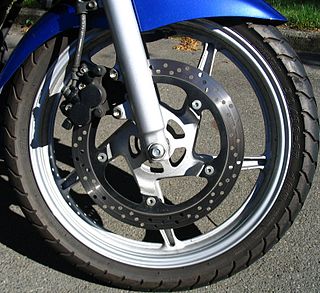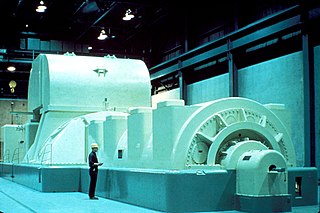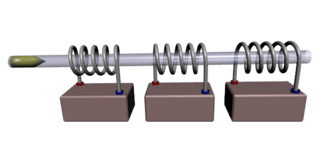This article relies largely or entirely on a single source .(December 2024) |
Magnetic damping [1] is a form of damping that occurs when a magnetic field (i.e. a magnet) travels some distance through or past an electrical conductor (or vice versa).
This article relies largely or entirely on a single source .(December 2024) |
Magnetic damping [1] is a form of damping that occurs when a magnetic field (i.e. a magnet) travels some distance through or past an electrical conductor (or vice versa).
When a magnetic field moves through a conductor the movement induces an eddy current in the conductor. The flow of electrons in the conductor immediately creates an opposing magnetic field which results in damping of the magnet and produces heat inside the conductor similar to heat buildup inside of a power cord during use. The amount of energy transferred to the conductor in the form of heat is equal to the change in kinetic energy lost by the magnet – the greater the loss of kinetic energy of a magnet (a product of its mass and speed), the greater the heat buildup in the conductor and the more forceful the damping effect. Eddy currents induced in conductors are much stronger as temperatures approach cryogenic levels. This allows for critical damping for cryogenic applications and testing in the aerospace industry.
The differential equation of motion of a magnet dropped vertically through or near a conductor, where "M" is the mass of the magnet, "K" is the damping coefficient, "v" is the velocity, "g" is gravity and "a" is the acceleration of the magnet:
As gravitational pull increases, the magnet's acceleration as it falls will tend to increase, except to the extent that the damping coefficient the magnet is experiencing (as a result of the conductor) increases, combined with the extent that the velocity of the magnet also increases – a magnet moving or falling quickly will have its acceleration (i.e., its increase in speed as it falls) reduced more than one moving or falling more slowly, and this effect on acceleration will be even more pronounced if the damping coefficient of the conductor is high.

Friction is the force resisting the relative motion of solid surfaces, fluid layers, and material elements sliding against each other. Types of friction include dry, fluid, lubricated, skin, and internal -- an incomplete list. The study of the processes involved is called tribology, and has a history of more than 2000 years.

A brake is a mechanical device that inhibits motion by absorbing energy from a moving system. It is used for slowing or stopping a moving vehicle, wheel, axle, or to prevent its motion, most often accomplished by means of friction.

Electromagnetic or magnetic induction is the production of an electromotive force (emf) across an electrical conductor in a changing magnetic field.

In electricity generation, a generator is a device that converts motion-based power or fuel-based power into electric power for use in an external circuit. Sources of mechanical energy include steam turbines, gas turbines, water turbines, internal combustion engines, wind turbines and even hand cranks. The first electromagnetic generator, the Faraday disk, was invented in 1831 by British scientist Michael Faraday. Generators provide nearly all the power for electrical grids.

Lenz's law states that the direction of the electric current induced in a conductor by a changing magnetic field is such that the magnetic field created by the induced current opposes changes in the initial magnetic field. It is named after physicist Heinrich Lenz, who formulated it in 1834.

A coilgun is a type of mass driver consisting of one or more coils used as electromagnets in the configuration of a linear motor that accelerate a ferromagnetic or conducting projectile to high velocity. In almost all coilgun configurations, the coils and the gun barrel are arranged on a common axis. A coilgun is not a rifle as the barrel is smoothbore.

Dynamic braking is the use of an electric traction motor as a generator when slowing a vehicle such as an electric or diesel-electric locomotive. It is termed "rheostatic" if the generated electrical power is dissipated as heat in brake grid resistors, and "regenerative" if the power is returned to the supply line. Dynamic braking reduces wear on friction-based braking components, and regeneration lowers net energy consumption. Dynamic braking may also be used on railcars with multiple units, light rail vehicles, electric trams, trolleybuses, and electric and hybrid electric automobiles.

A superconducting magnet is an electromagnet made from coils of superconducting wire. They must be cooled to cryogenic temperatures during operation. In its superconducting state the wire has no electrical resistance and therefore can conduct much larger electric currents than ordinary wire, creating intense magnetic fields. Superconducting magnets can produce stronger magnetic fields than all but the strongest non-superconducting electromagnets, and large superconducting magnets can be cheaper to operate because no energy is dissipated as heat in the windings. They are used in MRI instruments in hospitals, and in scientific equipment such as NMR spectrometers, mass spectrometers, fusion reactors and particle accelerators. They are also used for levitation, guidance and propulsion in a magnetic levitation (maglev) railway system being constructed in Japan.

In electromagnetism, an eddy current is a loop of electric current induced within conductors by a changing magnetic field in the conductor according to Faraday's law of induction or by the relative motion of a conductor in a magnetic field. Eddy currents flow in closed loops within conductors, in planes perpendicular to the magnetic field. They can be induced within nearby stationary conductors by a time-varying magnetic field created by an AC electromagnet or transformer, for example, or by relative motion between a magnet and a nearby conductor. The magnitude of the current in a given loop is proportional to the strength of the magnetic field, the area of the loop, and the rate of change of flux, and inversely proportional to the resistivity of the material. When graphed, these circular currents within a piece of metal look vaguely like eddies or whirlpools in a liquid.

A speedometer or speed meter is a gauge that measures and displays the instantaneous speed of a vehicle. Now universally fitted to motor vehicles, they started to be available as options in the early 20th century, and as standard equipment from about 1910 onwards. Other vehicles may use devices analogous to the speedometer with different means of sensing speed, eg. boats use a pit log, while aircraft use an airspeed indicator.
In physical systems, damping is the loss of energy of an oscillating system by dissipation. Damping is an influence within or upon an oscillatory system that has the effect of reducing or preventing its oscillation. Examples of damping include viscous damping in a fluid, surface friction, radiation, resistance in electronic oscillators, and absorption and scattering of light in optical oscillators. Damping not based on energy loss can be important in other oscillating systems such as those that occur in biological systems and bikes. Damping is not to be confused with friction, which is a type of dissipative force acting on a system. Friction can cause or be a factor of damping.

An eddy current brake, also known as an induction brake, Faraday brake, electric brake or electric retarder, is a device used to slow or stop a moving object by generating eddy currents and thus dissipating its kinetic energy as heat. Unlike friction brakes, where the drag force that stops the moving object is provided by friction between two surfaces pressed together, the drag force in an eddy current brake is an electromagnetic force between a magnet and a nearby conductive object in relative motion, due to eddy currents induced in the conductor through electromagnetic induction.
A dashpot, also known as a damper, is a mechanical device that resists motion via viscous friction. The resulting force is proportional to the velocity, but acts in the opposite direction, slowing the motion and absorbing energy. It is commonly used in conjunction with a spring. The process and instrumentation diagram (P&ID) symbol for a dashpot is .

A retarder is a device used to augment or replace some of the functions of primary friction-based braking systems, usually on heavy vehicles. Retarders serve to slow vehicles, or maintain a steady speed while traveling down a hill, and help prevent the vehicle from unintentional or uncontrolled acceleration when travelling on a road surface with an uneven grade. They are not usually capable of bringing vehicles to a standstill, as their effectiveness diminishes as a vehicle's speed lowers. Instead, they are typically used as an additional aid to slow vehicles, with the final braking done by a conventional friction braking system. An additional benefit retarders are capable of providing is an increase in the service life of the friction brake, as it is subsequently used less frequently, particularly at higher speeds. Additionally, air actuated brakes serve a dual role in conserving air pressure.

A magnetic track brake is a brake for rail vehicles. It consists of brake magnets, pole shoes, a suspension, a power transmission and, in the case of mainline railroads, a track rod. When current flows through the magnet coil, the magnet is attracted to the rail, which presses the pole shoes against the rail, thereby decelerating the vehicle.
In electrical engineering, electric machine is a general term for machines using electromagnetic forces, such as electric motors, electric generators, and others. They are electromechanical energy converters: an electric motor converts electricity to mechanical power while an electric generator converts mechanical power to electricity. The moving parts in a machine can be rotating or linear. While transformers are occasionally called "static electric machines", since they do not have moving parts, generally they are not considered "machines", but as electrical devices "closely related" to the electrical machines.
Flux pumping is a method for magnetising superconductors to fields in excess of 15 teslas. The method can be applied to any type II superconductor and exploits a fundamental property of superconductors, namely their ability to support and maintain currents on the length scale of the superconductor. Conventional magnetic materials are magnetised on a molecular scale which means that superconductors can maintain a flux density orders of magnitude bigger than conventional materials. Flux pumping is especially significant when one bears in mind that all other methods of magnetising superconductors require application of a magnetic flux density at least as high as the final required field. This is not true of flux pumping.
Electromagnetic clutches and brakes operate electrically, but transmit torque mechanically. This is why they used to be referred to as electro-mechanical clutches or brakes. Over the years, EM became known as electromagnetic versus electro mechanical, referring more about their actuation method versus physical operation. Since the clutches started becoming popular over 60 years ago, the variety of applications and brake and clutch designs has increased dramatically, but the basic operation remains the same.
This glossary of physics is a list of definitions of terms and concepts relevant to physics, its sub-disciplines, and related fields, including mechanics, materials science, nuclear physics, particle physics, and thermodynamics. For more inclusive glossaries concerning related fields of science and technology, see Glossary of chemistry terms, Glossary of astronomy, Glossary of areas of mathematics, and Glossary of engineering.